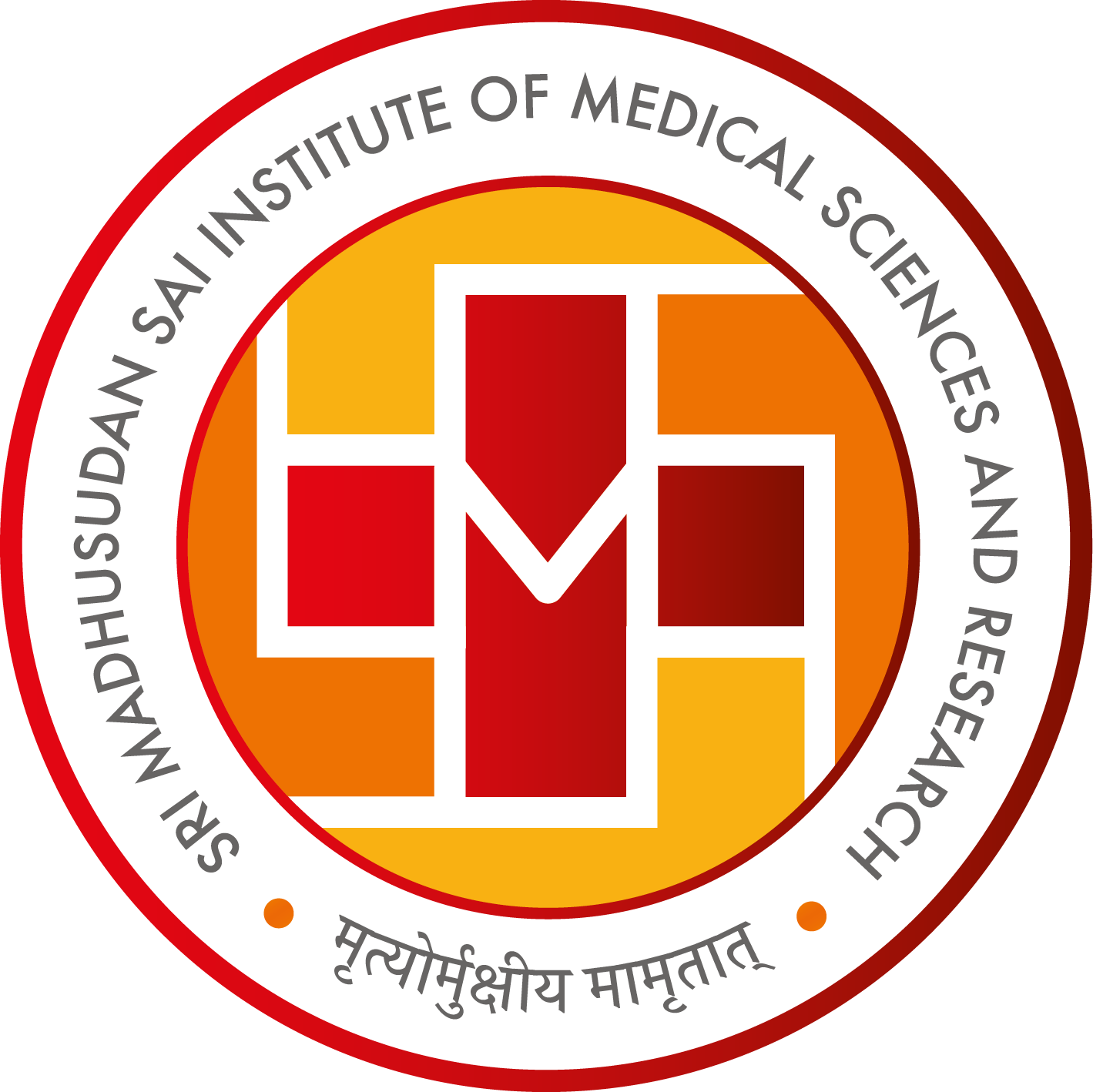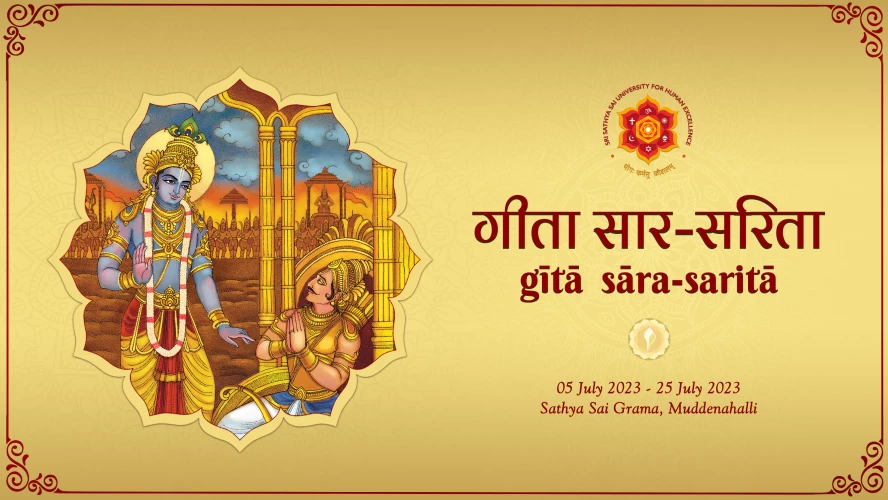05 - 25 JULY 2023
In line with values-based education, all students from 9th grade and above participated in a 20-day long Bhagavad Gita workshop. The workshop commenced at 9 a.m. every day, during which students learned the Gita chapter by chapter. In the afternoon, students discussed and asked questions regarding the chapter they had just learned.
In the evening, Sadguru Shri Madhusudan Sai himself gave a discourse on that day's chapter to all the students and viewers worldwide. He also answered questions from devotees and students after the discourse. The Chancellor of the University, Sri B N Narasimha Murthy, also spoke every day and shed light on each chapter. Our Chancellor is a great example to students, possessing in-depth knowledge of the Bhagavad Gita and other texts from both within and outside India.
Short Summary:
सर्वोपनिषदो गावो दोग्धा गोपाल नन्दनः।
पार्थो वत्सः सुधीर्भोक्ता दुग्धं गीतामृतं महत् ।।
This is one of the most famous Dhyana Shlokas chanted before undertaking the study of Bhagavad Gita. The Upanishads are compared to a cow, the milkman being Sri Krishna Bhagwan who milks the cow, and the eager calf is Arjuna. The milk is compared to the Bhagavad Gita, which is verily the essence of all the Upanishads.
Sadguru has quoted, “The Bhagavad Gita - the crest jewel of all scriptures, guides one to attain moksha through selfless work, meditative worship, and the wisdom of the Self.”
The Academic Year 2023-2024, therefore, began with the Para Vidya Shibira, based on the Bhagavad Gita, an instruction manual for human life. The Shibira, spread across 20 days, was attended by students, staff, and devotees from around the world. Sadguru himself devised a unique schedule to make this Shibira more effective, with the day starting with early morning prayers, Yoga sessions, and meditation. Thereby, we listened to Sadguru’s video explanations, one chapter a day, followed by interactive study circles in the afternoon. In the evening, Sadguru graciously blessed us with further insights and answered our queries. The day would end with Swadhyaya and Hanuman Chalisa.
The Bhagavad Gita is one comprehensive text among all Indian scriptures. It traces the spiritual journey of Arjuna from sorrow to surrender. Therefore, the Gita is considered to be the most practical text to date.
The first chapter, Arjuna Vishada Yoga, explains how Krishna strategically places Arjuna’s Chariot in front of his grandfather and Gurus, paving the way for the development of attachment in Arjuna. This chapter teaches us that attachment leads to wrong decision-making.
The second chapter, Sankhya Yoga, is the crux or essence of Bhagavad Gita. This chapter marks the beginning of Krishna’s Upadesha, wherein Krishna analytically explains to Arjuna his Dharma. The essence of this chapter is the quality of equanimity.
Karma Yoga stresses how action is inevitable, and any action we perform has consequences. To overcome the consequences, Krishna suggests offering the actions unto him.
Jnana Karma Sannyasa Yoga talks about the higher understanding of who is the real doer in the first place. This chapter tells that the act, the doer, and the enjoyer are all Brahman.
The 5th chapter, Karma Sannyasa Yoga, teaches us to perform our actions perfectly without expecting any outcome, rather than renouncing the fruits of the action. This can be achieved by establishing ourselves in that Divinity, setting the context for Dhyana Yoga.
In the sixth chapter, Krishna teaches Arjuna how one must constantly practice to steady his/her mind through the process of Dhyana.
This brings us to Jnana Vijnana Yoga, wherein Krishna tells Arjuna to whom he must meditate. In addition, Krishna describes His Apara and Para Prakrti.
Akshara Brahma Yoga is a beautiful elaboration of several Advaitic concepts. It also touches on the role of thoughts one has during the last moments in determining our next birth.
The top-most secret is what follows in the 9th chapter aptly titled Raja Vidya Raja Guhya Yoga. In this chapter, Krishna reveals His Yogamaya wherein He permeates everything and everything exists in Him, yet He doesn’t permeate anything and nothing exists in Him. This concept is explained through the Rajju-Sarpa Nyaya.
Vibhuti Yoga, as the name suggests, beautifully describes the glory of Bhagwan Sri Krishna as the Supreme Divinity. Lord Krishna gives glimpses of His Glory by describing Himself as the best among each category.
Arjuna, having immersed himself in the Glory of the Lord, wanted to experience it for real. He humbly prayed to Krishna to show him His Vishwaroopa, which forms the 11th Chapter. Sadguru describes that True Vishwaroopa Darshana is to see the Divinity in all existence.
From here, Krishna slowly leads us to Bhakti Yoga, wherein he describes the traits of a true devotee, by developing which, we too can become dear to God.
The 13th Chapter, Kshetra Kshetrajna Vibhaga Yoga, is another chapter pregnant with important concepts such as Kshetra and Kshetrajna, Purusha and Prakrti, Kshara and Akshara, etc. Further, Krishna explains that He is the Purusha in all Prakrti.
Gunatraya Vibhaga Yoga answers an important question that is bound to arise: why are we not able to experience the Divinity in everything? It is due to our three Gunas - Sattva, Rajas, and Tamas. Among the three, the Sattva Guna aids in our spiritual evolution. Therefore, the role of Satsanga i.e., good company is of paramount importance to develop the Sattva Guna.
Purushottama Yoga is unique among all the chapters as it talks about an upside-down Ashwatta Tree, depicting the factors that bind us to the world. Further, Krishna describes how he is not just the Purusha but the Purushottama.
Daivasura Sampad Vibhaga Yogah is the 16th chapter, which clearly distinguishes between divine and demoniac qualities. This chapter allows us to evaluate ourselves based on these qualities.
Sraddha is an important quality for a spiritual seeker. Therefore, Krishna talks about it in great detail in the 17th chapter, Sraddhatraya Vibhaga Yoga. Sraddha can also be classified as Sattva, Rajas, and Tamas, which in turn, determines the Yajna, Tapas, and Dana that we undertake.
Moksha Sannyasa Yoga is the summary, the sum, and substance of the entire Bhagavad Gita. Here, he introduces a few more concepts and briefly explains them. Ultimately, towards the end, he leaves the choice to Arjuna. But Arjuna being a good disciple, declares, “Karishye Vacanam Tava,” which means “I shall do as You say.”
Thus, the Bhagavad Gita ends with a beautiful assurance, that wherever there is Yogeshwara Krishna and Partho Dhanurdharah, victory and prosperity shall pertain. This statement is a symbol. The Ultimate Goal of the Bhagavad Gita, being a Yogashastra, Upanishad, and Brahmavidya, is the amalgamation of the Jeevatma with the Paramatma, leading to Sri and Vijaya.
Link to Gita Sara Sarita & Essence of Bhagavad Gita by Sadguru:
Daily Q&A sessions with Sri Madhusudan Sai on the essence of Bhagavad Gita from 05 to 25 July, 2023. Explore its timeless teachings and practical applications with lucid explanations by Sri Madhusudan Sai: https://www.youtube.com/playlist?list=PLvctceCTQG8JlaznBZLdhjlclA-wlYPCm
Essence of Bhagavad Gita by Sadguru Sri Madhusudan Sai: https://www.youtube.com/playlist?list=PLvctceCTQG8LPtxOJTjmPqlWKpDY5-oXb



